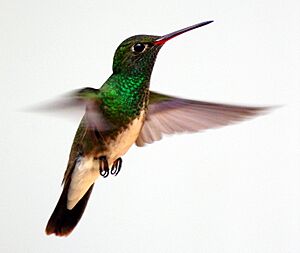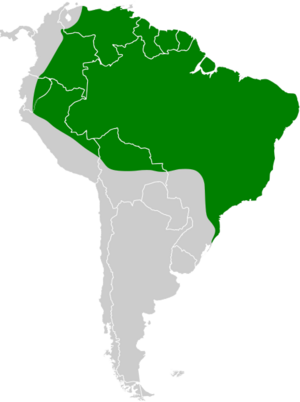Glittering-throated emerald facts for kids
Quick facts for kids Glittering-throated emerald |
|
|---|---|
 |
|
| Glittering-throated emerald | |
| Conservation status | |
| Scientific classification | |
| Genus: |
Chionomesa
|
| Species: |
fimbriata
|
 |
|
| Synonyms | |
|
|
The glittering-throated emerald (Chionomesa fimbriata) is a type of hummingbird. It belongs to a group of hummingbirds called "emeralds". You can find this bird in many South American countries. These include Bolivia, Brazil, Colombia, Ecuador, the Guianas, Peru, Trinidad, and Venezuela.
Contents
About the Glittering-Throated Emerald
How it Got its Name
The glittering-throated emerald was first officially described in 1788. A German scientist named Johann Friedrich Gmelin gave it its first scientific name, Trochilus fimbriatus. He based his description on earlier works by French naturalists.
This hummingbird used to be placed in a different group, or genus, called Amazilia. But in 2014, scientists studied its DNA. They found that Amazilia was not a single, clear group.
Because of this, the glittering-throated emerald was moved. Most scientists now place it in the genus Chionomesa. This genus name was first used in 1921.
The name Chionomesa comes from Ancient Greek words. Khiōn means "snow" and mesos means "middle". The second part of its scientific name, fimbriata, is Latin. It means "fringed".
Different Types of Glittering-Throated Emeralds
There are seven known types, or subspecies, of the glittering-throated emerald. Each subspecies has slight differences.
- C. f. elegantissima
- C. f. fimbriata
- C. f. apicalis
- C. f. fluviatilis
- C. f. laeta
- C. f. nigricauda
- C. f. tephrocephala
Some of these subspecies, like C. f. apicalis and C. f. tephrocephala, were once thought to be separate species.
What it Looks Like
The glittering-throated emerald is a small bird. It is about 8 to 12 centimeters (3 to 4.7 inches) long. It weighs between 3.5 and 6.2 grams (0.12 to 0.22 ounces).
Both male and female birds have a straight beak. The top part of the beak is blackish. The bottom part is pinkish with a dark tip.
Adult males of the most common type (C. f. fimbriata) have shiny, bronze-green upper parts. Their tail is dark bronze-green to blackish. Their throat and most of their chest are a sparkling golden-green. The lower part of their chest and belly are white.
Adult females look similar to males. However, they have white bars on their throat feathers. Their outer tail feathers also have greenish-gray tips. Young birds look like adult females but have a more grayish-brown chest.
Some subspecies have unique features. For example, C. f. elegantissima has coppery or purplish upper tail feathers. C. f. fluviatilis and C. f. laeta have a turquoise or bluish shine on their throats.
Where it Lives
The different subspecies of the glittering-throated emerald live in various parts of South America:
- C. f. elegantissima lives in northern and western Venezuela and parts of Colombia.
- C. f. fimbriata is found from Venezuela through the Guianas and northern Brazil.
- C. f. apicalis lives in Colombia, east of the Andes mountains.
- C. f. fluviatilis is in southeastern Colombia and eastern Ecuador.
- C. f. laeta can be found in northeastern Peru and possibly western Brazil.
- C. f. nigricauda lives in eastern Bolivia and central and eastern Brazil.
- C. f. tephrocephala is found along the coast of southeastern Brazil.
This hummingbird lives in many open or partly open areas. It avoids dense forests. You can find it in dry or humid forests, woodlands, savannas, and even gardens. One subspecies, C. f. tephrocephala, also lives in mangrove swamps.
Behavior and Life Cycle
Movement
One subspecies, C. f. tephrocephala, travels north and south along the coast. Other types of glittering-throated emeralds are thought to move locally. However, scientists do not have much information on their exact movements.
Feeding Habits
The glittering-throated emerald eats nectar from many different flowers. It visits various herbs, bushes, vines, and trees. It often follows a regular path, visiting the same flowers in a circuit. This is called "trap-lining." It usually feeds low in trees. Besides nectar, it also eats small insects.
Reproduction
The breeding season for the glittering-throated emerald changes depending on where it lives. For example, in Guyana, it breeds in August and September. In central Brazil, it breeds from November to February.
The female bird builds a cup-shaped nest. She uses plant fibers and spiderwebs to hold it together. She often puts lichen on the outside of the nest. Nests are usually built between 1 and 4 meters (3 to 13 feet) above the ground. Sometimes they are as high as 8 meters (26 feet).
The female lays two eggs. She sits on them for 14 to 17 days. The young birds usually leave the nest 18 to 22 days after hatching. It is common for these birds to have two sets of babies each year.
Sounds and Calls
The song of the glittering-throated emerald is a repeated, high-pitched buzzing sound. It sounds like "tzee...tzee...tzee..." and is often heard at dawn. When flying or fighting, it makes a repeated high, thin sound. This can be "tsee…tsi-tsi-tsitsitsi" or "tslee-tslee-tslee-tslee". Its other calls include high-pitched "tsee" notes and soft chattering sounds.
Conservation Status
The IUCN (International Union for Conservation of Nature) has listed the glittering-throated emerald as a species of "Least Concern." This means it is not currently considered to be at risk of extinction.
The bird lives across a very large area. Scientists do not know its exact population size or if its numbers are changing. However, no immediate threats have been found. It is common in many parts of its range, especially in the north and east. The populations in western areas are not as well studied. One subspecies, C. f. tephrocephala, is common in some places but generally not widespread.


